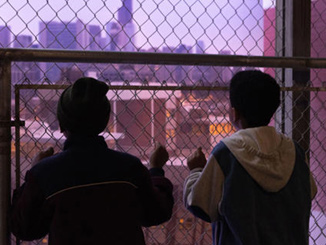

Minhal Baig’s We Grown Now is a coming-of-age story about two adolescent boys set in Chicago’s Cabrini-Green housing project.The film won the Shawn Mendes Foundation Changemaker Award at the Toronto International Film Festival -TIFF 2023, and two awards (Chicago Award, Best U.S. Feature Audience Award) at Chicago 2023.
The story is set in the 90s were Malik (Blake Cameron James) and Eric (Gian Knight Ramirez) are best friends growing up in a working class African-American community. Malik lives with his hardworking mom (Jurnee Smollett), his sister, and also his grandmother (S. Epatha Merkerson) who came years ago from Mississippi. Friends since birth, Malik and school chum Eric are inseparable,“flying” onto old mattresses, goofing off or telling corny jokes. “What do you call three trees?” “A trio.” But things change after a fatal shooting (based on the real-life death of seven-year-old Dantrell Davis, a tragedy that shook the community and made the projects a symbol of urban blight).
Originally built to house World War II workers in the 1940s, Cabrini-Green became a refuge for African-Americans seeking relief from the Southern States in the 1950s.
Since Cabrini-Green was demolished in 2011, the filmmakers had to re-create the landscape – its bleak high-rises contrasting with warm interiors. Baig shows an eye for details, be it a jump rope casting long shadows, Eric sporting a Bulls t-shirt, or the boys talking through a chain link fence. The film is reminiscent of other such coming-of-age films like Stand By Me.
The film is written and directed by Chicagoan Minhal Baig (Hala) who came up with the idea after her father died. She and her siblings agonized about whether to sell his house, finally realizing that “Home was a place, and a place is the people.” Baig interviewed many who had lived in Cabrini-Green. Annette Freeman, mother of Dantrell Davis, was a consultant on the film.
The story could be in any inner city in North America where racialized working-class families struggle to survive in the face of multiple barriers of economic struggle, bigotry and police brutality. Although set in the 90s Chicago, the story is still relevant today as some of the same struggles still continue. A scene police brutality where a late-night raid of family homes with children were ran sacked in search for drugs still happens today.
